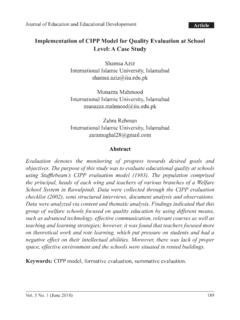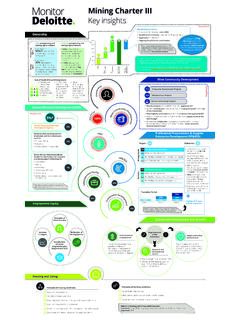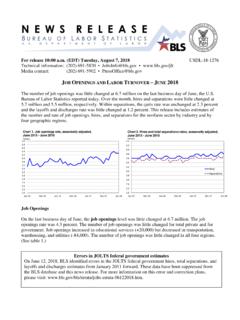Transcription of DENR Administrative Order No. SUBJECT: GUIDELINES ON ...
1 DENR Administrative Order No. Series of 2017. SUBJECT: GUIDELINES ON PUBLIC PARTICIPATION UNDER THE. PHILIPPINE ENVIRONMENTAL impact STATEMENT. (EIS) SYSTEM. Consistent with the thrust of the Department of Environment and Natural Resources (DENR) to promote social justice and the 1992 Declaration of United Nations Conference on Environment and Development (UNCED). emphasizing that environmental issues are best handled with the participation of all concerned citizens, the following GUIDELINES on Public Participation are hereby promulgated. ARTICLE I. BASIC POLICY AND PRINCIPLES, OBJECTIVES, SCOPE AND. DEFINITION OF TERMS. Section 1. Basic Policy and Principles T. It is hereby declared a policy that to promote common good amidst the country's economic development initiatives, public participation shall be an integral part in the implementation of the Philippine EIS System and shall AF.
2 Employ the following basic principles. a) Public Participation should be initiated early and sustained at the various stages of the EIA Process. R. b) Public Participation should be well planned and should involve the stakeholders in the assessment, management and monitoring of environmental impacts D. c) Timely disclosure of all necessary relevant information shall be provided to the public especially to the stakeholders who shall be made to understand and appreciate the specific purpose and context of their participation for each stage of the process. Section 2. Objectives and Outcome The objective of this Administrative Order is to improve and rationalize Public Participation under the Philippine EIS System by incorporating best practice principles and standardizing the procedures and requirements.
3 The intended outcome of this Order is to achieve meaningful public participation under the Philippine EIS System at the various stages of the EIA. Process through: a) An effective information disclosure and feedback mechanism for: The gathering of all relevant baseline data / information, issues and concerns that should be included in the EIA study The review of the contents of the EIS. The management and monitoring of environmental impacts of 4/6/2017 Version 3. projects/undertakings b) Enhanced understanding and transparency and reduced risk of misinformation, distrust and conflict c) Defined roles in decision making d) Empowered citizens in taking responsibility in environmental protection Section 3. Scope of Public Participation Requirement Public participation under the Philippine EIS system shall be required for the entire EIA Process from social preparation prior to scoping to impact management and monitoring during project implementation/abandonment for projects requiring an Environmental impact Statement (EIS) per existing GUIDELINES .
4 Section 4. Definition of Terms For purposes of this GUIDELINES , the following definitions shall be applied: Compliance Monitoring Report (CMR) a semi-annual report submitted by the project proponent to EMB to report its self-monitoring of compliance with the requirements under the Philippine EIS System. Compliance Monitoring and Validation Report (CMVR) a semi-annual T. monitoring report form for MMTs for submission to EMB. Environment- shall refer to the totality of the external conditions affecting life, AF. development and survival of organisms including the surrounding air, water (both ground and surface), land, flora, fauna, humans and their interrelations. Environmental Aspects elements of an organization's activities, products or services that can interact with the environment.
5 R. Environmental Compliance Certificate (ECC) is a document that may be issued after thorough review of the EIA Report. It certifies that the proposed project has complied with the requirements of the EIS System and that the D. proponent has committed to implement its approved Environmental Management Plan (EMP) to address the environmental impacts and to operate within the best environmental practice. Environmental impact Assessment (EIA) a process that involves predicting, monitoring and evaluating the impacts of a project (including cumulative impacts) on the environment during construction, commissioning, operation and abandonment. It also includes designing appropriate preventive, mitigating and enhancement measures to address these consequences to protect the environment and the community's welfare.
6 Environmental impact Assessment Review Committee (EIARC) - a body of independent technical experts and professionals of known probity from various fields organized by the EMB to evaluate the EIS and other related documents and to make appropriate recommendations regarding the issuance or non- issuance of an ECC. Environmentally Critical Project (ECP) - project or program that has high potential for significant negative environmental impacts as defined under Presidential Proclamations 2146 (1981) and 803 (1996) and described under existing EMB GUIDELINES and such other projects that may be declared by the 4/6/2017 Version 3. President. Environmental impact Statement (EIS) an EIA Report type that is required to be submitted for ECC application for proposed ECPs and other project types that are expected to have a high degree of environmental impact significance.
7 Environmental Management Plan/Program (EMP) is a section in the EIS. that details the prevention, mitigation/management and monitoring measures to enhance positive impacts and minimize negative impacts and risks of a proposed project or undertaking. It also includes contingency and compensation plan for environmental impacts and risks. Environmental Monitoring Plan (EMoP) a part of the EMP which indicates specific parameters to the monitored for identified environmental aspects and impacts, the sampling and measurement plan and the corresponding management scheme. Environmental Monitoring Fund (EMF) a fund that a proponent shall set up after an ECC is issued for its project or undertaking, to be used to support the activities of the multi-partite monitoring team formed for ECPs.
8 It shall be immediately accessible and easily disbursable. Environmental Performance Report and Management Plan (EPRMP) - an T. EIA Report type that is required to be submitted for ECC application for single projects that are already operating. It includes a documentation of the actual AF. cumulative environmental impacts, a report on the effectiveness of measures that are currently being implemented and additional management measures to enhance the effectiveness of the current measures or address additional impacts from proposed expansion/modification of the project/undertaking as necessary. R. Focus group discussion (FGD) is a rapid assessment, semi-structured data gathering method in which a purposively selected set of participants gather to D.
9 Discuss and deliberate on a specific topic. It has normally a small number of participants, just enough to generate rich discussion. impact Management Plan (IMP) a part of the EMP which indicates the prevention/mitigation measures for identified environmental aspects and impacts. It also indicates the responsible entity/ies, costs and guarantee/financial arrangements for the implementation of the prevention and/or mitigation measures Key Informant Interview (KII) is an interview of people selected for their firsthand knowledge about the topic of interest designed to allow free flow of ideas. Multipartite Monitoring Team (MMT) - an independent entity whose membership represents primarily the stakeholders / public that is intended to assist the DENR in monitoring environmental impacts and compliance with the Philippine EIS System requirements and other environmental laws as a third party entity.
10 The MMT scheme is intended to enhance participation and transparency at the post-ECC issuance stage of the EIA Process. Programmatic Environmental impact Statement (PElS) - an EIA Report type that is required to be submitted for ECC application for proposed co- 4/6/2017 Version 3. located projects intending to undergo programmatic compliance. It includes a documentation of comprehensive studies on environmental baseline conditions of a contiguous area and an assessment of the carrying capacity of the area to absorb impacts from co-located projects such as those in industrial estates or economic zones (ecozones). Programmatic Environmental Performance Report and Management Plan (PEPRMP) - an EIA Report type that is required to be submitted for ECC.
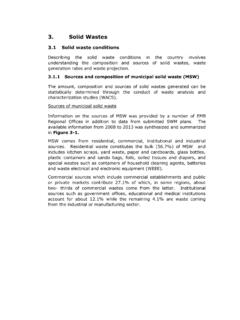


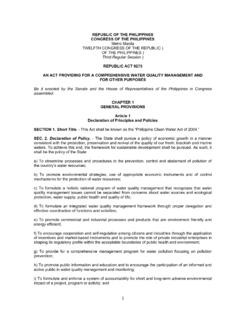


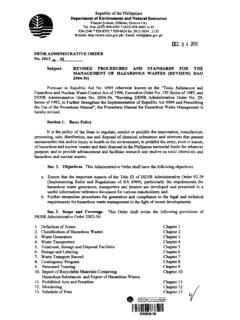


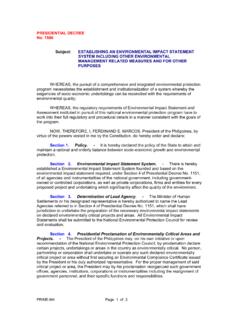

![STANDARD TERMS OF REFERENCE [TOR] FOR EIA / EMP …](/cache/preview/a/4/c/9/a/b/5/f/thumb-a4c9ab5ff9eff75d8a48f0eda9378841.jpg)


